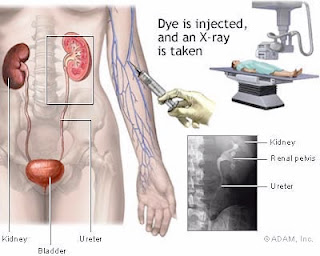 |
| cervical cancer test |
Screening methods to find cervical changes that may lead to cervical cancer include the Pap test and HPV testing. Screening may find cancers early, when they are most treatable.
Pap smears screen for pre-cancers and cancer, but do not offer the final diagnosis. If abnormal changes are found, the cervix is usually examined under intensification. This is called colposcopy. Pieces of tissue are surgically removed (biopsied) during this procedure and sent to a laboratory for examination.
- Endocervical curettage (ECC) to examine the opening of the cervix
- Cone biopsy
If the woman is diagnosed with cervical cancer, the health care provider will order more tests to determine how far the cancer has spread. This is called staging.
Cervical Cancer Tests may include:
 |
| Intravenous pyelogram (IVP) |
- CT scan
- Cystoscopy
- MRI
- Chest x-ray
- Intravenous pyelogram (IVP)




